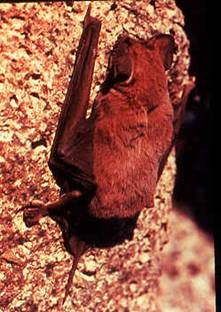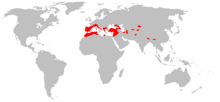
The Molossidae, or free-tailed bats, are a family of bats within the order Chiroptera. The Molossidae is the fourth-largest family of bats, containing about 110 species as of 2012. They are generally quite robust, and consist of many strong-flying forms with relatively long and narrow wings with wrinkled lips shared through their genus. Their strong flying form allows them to fly 60 miles per hour using tail winds and at altitudes over 10,000 feet. This makes them unique among bats, as they are the only bat family that withstands the elevation. They are widespread, being found on every continent except Antarctica. They are typically found in caves, abandoned mines, or tunnels.

The genus Tadarida has 9 or more species of free-tailed bats divided into two subgenera, with the first of these containing seven species spread across the Old World. Four species occur exclusively in Africa including Madagascar while two more species occur in central Papua New Guinea, and western and southern Australia, respectively.

The Mexican free-tailed bat or Brazilian free-tailed bat is a medium-sized bat native to the Americas, regarded as one of the most abundant mammals in North America. Its proclivity towards roosting in huge numbers at relatively few locations makes it vulnerable to habitat destruction in spite of its abundance. It has been claimed to have the fastest horizontal speed of any animal, reaching top ground speeds over 101 mph (162 km/h); its actual air speed has not been measured. The Texas Legislature designated the Mexican free-tailed bat the state mammal (flying) in 1995.

Natterer's bat is a European vespertilionid bat with pale wings. It has brown fur tending to greyish-white on its underside. It is found across most of the continent of Europe, parts of the Near East and North Africa. It feeds on insects and other invertebrates which it catches on the wing or pursues on the ground.

The yellow-winged bat is one of five species of false vampire bat from Africa.

Ozimops planiceps is a small bat in the family Molossidae, native to Australia and Indonesia.

The Natal free-tailed bat is a species of bat in the family Molossidae, the free-tailed bats. It is endemic to the island of Mauritius. It is known from fewer than five locations in its range, but it is common at a few sites. It roosts in caves, and it is considered to be an endangered species due to disturbance of its cave habitat.

The little goblin bat is a species of bat in the family Molossidae, the free-tailed bats. It is endemic to Cuba.

The Incan little mastiff bat is a species of bat in the family Molossidae, the free-tailed bats. It belongs to the subgenus Micronomus.

Hildegarde's tomb bat is a species of sac-winged bat in the family Emballonuridae. It is found near the coast in Kenya and Tanzania where it feeds in tropical dry forests and roosts in caves. It is a diurnal species and the International Union for Conservation of Nature has assessed its conservation status as being endangered. The specific name hildegardeae was given in honour of anthropologist Hildegarde Beatrice Hinde.

Ansorge's free-tailed bat is a species of bat in the family Molossidae native to sub-Saharan Africa. It is named for W.J. Ansorge, who collected the first formally described specimen.

The Nigerian free-tailed bat is a species of bat in the family Molossidae. It is native to two widely separated parts of Africa, and is sometimes considered to represent two separate species.

The pocketed free-tailed bat is a species of bat in the family Molossidae found in Mexico and in Arizona, California, New Mexico, and Texas in the United States. They resemble the Brazilian free-tailed bat but differ morphologically. They are recognized as "least concern" by the IUCN and as "apparently secure" by Natureserve.
The big-eared mastiff bat is a species of bat in the Molossidae family endemic to Papua New Guinea. It is only known from eleven specimens and it is not easy to survey. It forages in rainforest canopy and roosts in tree hollows. It is likely more widespread than currently known but additional research is needed.

The Egyptian free-tailed bat, also known as Egyptian guano bat or Egyptian nyctinome, is a species of bat in the family Molossidae.

The white-striped free-tailed bat is a species of bat in the family Molossidae. Its echolocation calls are audible to humans, which is a characteristic found in only a few microbat species. The species was formerly classified as Tadarida australis.

Chaerephon is a genus of Old World free-tailed bats in the family Molossidae. Molecular sequence data indicates that Chaerephon, Mops and Tadarida are not monophyletic taxa. The closest relatives of Chaerephon jobimena of Madagascar are Tadarida aegyptiaca of Africa and southwest Asia, and Tadarida brasiliensis of the Americas, which form a clade believed to be about 9.8 million years old. However, the grouping of Chaerephon minus C. jobimena plus Mops was found to be monophyletic.
The East Asian free-tailed bat was formerly considered to belong to the same species as the European free-tailed bat. Its range includes China, Japan, and the Korean Peninsula.


















